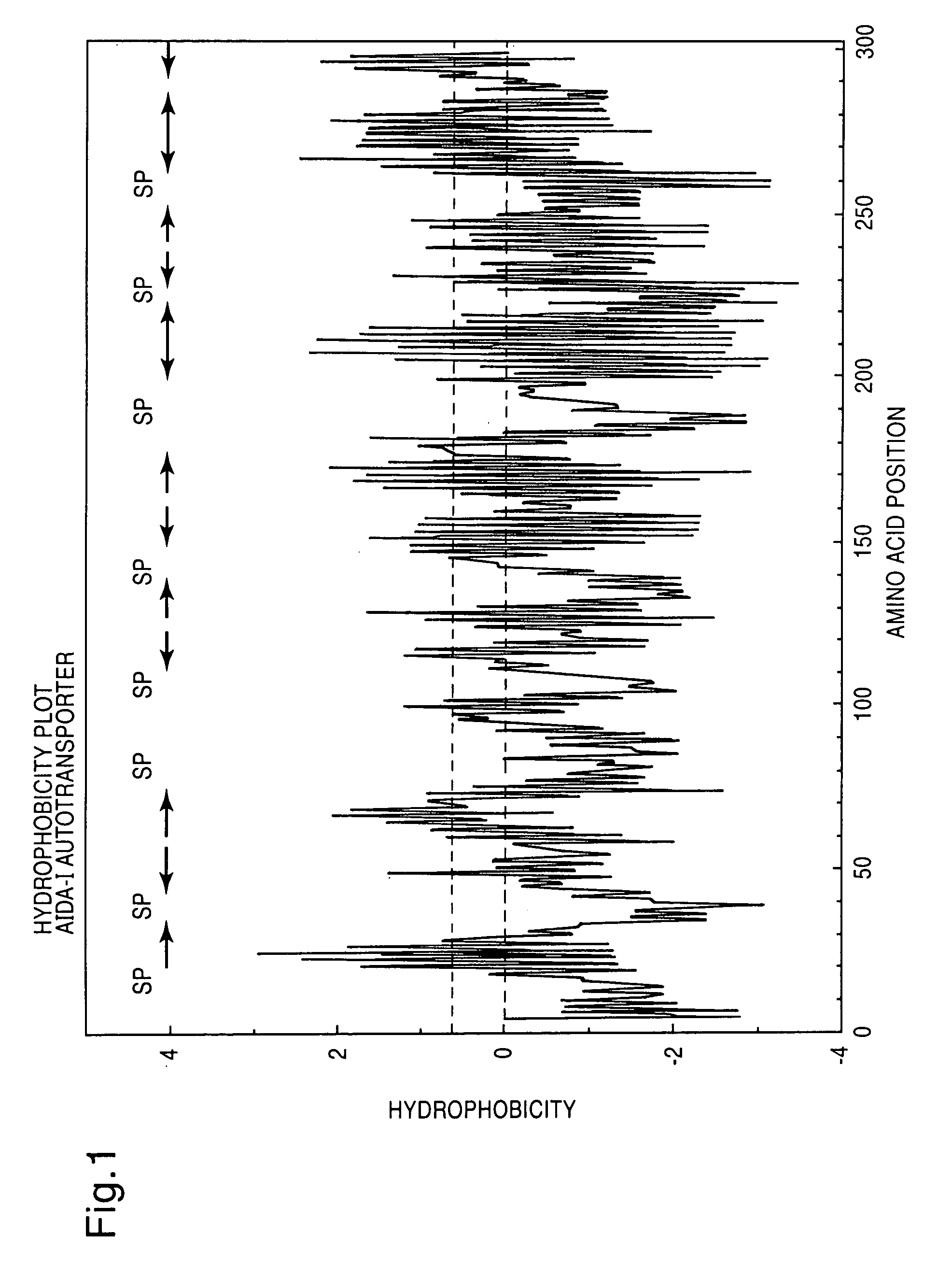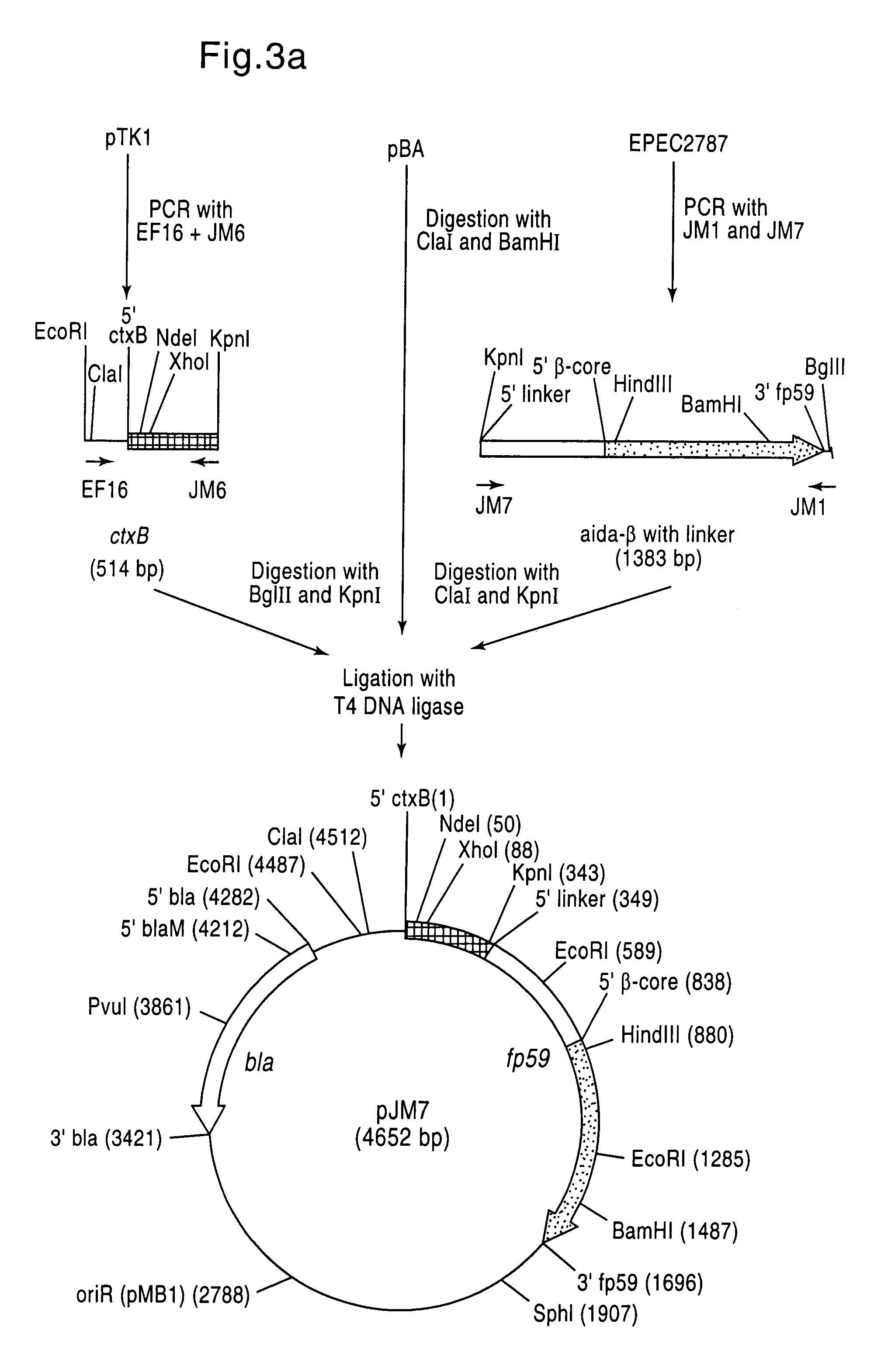Export systems for recombinant proteins
a technology of recombinant proteins and export systems, which is applied in the field of vectors and host vector combinations, can solve the problems of preventing correct folding or functioning, causing frequent compatibility problems, and finding considerable disadvantages, so as to improve efficiency, promote stability of interaction, and produce and present proteins stable
- Summary
- Abstract
- Description
- Claims
- Application Information
AI Technical Summary
Benefits of technology
Problems solved by technology
Method used
Image
Examples
example 1
Identification and Localization of the Autotransporter in a Surface Protein of Escherichia coli.
[0124]In order to find an autotransporter appropriate for the required use, that is to say adapted to the passenger protein and the host strain to be used, it is necessary to carry out an analysis of the C-terminal amino-acid sequence of a protein under consideration. This may be a protein already identified as surface factor, or else an amino-acid sequence, deposited in a data bank, of a protein of unknown function, or an amino-acid sequence, derived from a DNA sequence deposited in a data bank, of a protein, or the amino-acid sequence, derived from a gene following a sequence analysis, of a protein. The N terminus of the protein ought to contain a signal peptide sequence in order to make transport across the inner membrane possible, and the part integrated into the membrane ought to start at the C terminus with the aromatic amino acid phenylalanine or tryptophan, followed by alternatel...
example 2
Construction of a Surface-Exposed Fusion Protein Having an Antigenic Determinant as Passenger Protein
[0126]Based on the assumptions that AIDA-I is an autotransporter and that a gene fusion of any desired passenger and an autotransporter intrinsic to E. coli (namely AIDA-β) ought to be more compatible with E. coli than a gene fusion of the same passenger with a heterologous autotransporter (for example Iga-β), a gene fusion was produced between aida-β and a gene for a passenger protein. In order to ensure transport of the passenger, not only AIDA-β but also a connecting region (“linker”) located on the N-terminal side of the β-barrel was cloned.
[0127]CtxB was selected as passenger, and the corresponding gene from pTK1 (Klauser et al, EMBO J. 9 (1990), 1991–1999) was amplified by PCR using the oligonucleotides EF16 and JM6. Since AIDA-I is plasmid-encoded in E. coli EPEC 2787 (Benz and Schmidt, Infect. Immun. 57 (1989), 1506–1511), the AIDA-I auto-transporter with linker region was li...
example 3
Construction of a Surface-Presented Peptide Fusion
[0133]A peptide which acts as linear epitope for a monoclonal antibody (Dü142) was presented and detected on the surface. The peptide was cloned using a PCR-dependent strategy which is extremely suitable for the generation and surface exposure of peptide libraries. This entails formation of a triple gene fusion of the export signal of ctxB (bases 1–81), of a short sequence coding for a peptide (bases 82–96) and of the aida linker / aida-β region (bases 103–1450).
[0134]pJM7 (FIG. 3a) was linearized with XhoI and used as template (FIG. 3b) for a PCR with the oligonucleotides JM7 and JM20 (FIG. 6). Both oligonucleotides had a KpnI recognition sequence at their 5′ ends [lacuna] JM7 was chosen so that, on use thereof in a PCR, the aida linker / aida-β domains were amplified. JM20 was chosen so that the PCR product contained the signal sequence present in ctxB for the Sec-dependent membrane transport through the cytoplasmic membrane and the si...
PUM
| Property | Measurement | Unit |
|---|---|---|
| optical density | aaaaa | aaaaa |
| mass | aaaaa | aaaaa |
| length | aaaaa | aaaaa |
Abstract
Description
Claims
Application Information
 Login to View More
Login to View More - R&D
- Intellectual Property
- Life Sciences
- Materials
- Tech Scout
- Unparalleled Data Quality
- Higher Quality Content
- 60% Fewer Hallucinations
Browse by: Latest US Patents, China's latest patents, Technical Efficacy Thesaurus, Application Domain, Technology Topic, Popular Technical Reports.
© 2025 PatSnap. All rights reserved.Legal|Privacy policy|Modern Slavery Act Transparency Statement|Sitemap|About US| Contact US: help@patsnap.com



